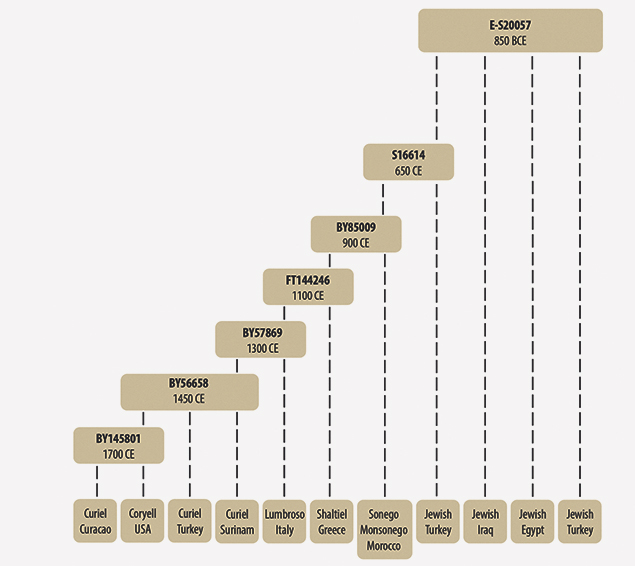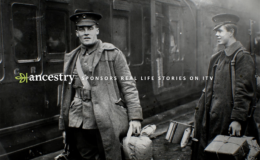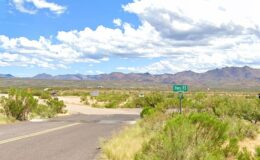
Imagine the broad sweep of the history of the Jewish people over the last 3,200 years, give or take, encoded into our bodies in ways that scientists are beginning to learn how to read, with each of us having a tiny bit of information that can add to that massive database that is us.
That’s the assumption that the Avotaynu DNA Project has chosen to explore. Using Y chromosomes, which men carry, largely unaltered from the generations that preceded them — except for the occasional mutations that also are like manna to researchers — and hand down to their male descendants, Avotaynu has traced large-scale movements, connected them to historic developments, and connected Jews both to their pasts and to each other. (And no, this project, with its focus on men, isn’t sexist; it’s just that Y chromosomes, which only men carry, tell the most legible family histories, at least given our current level of knowledge.)
Now, imagine that mile-high focus zooming in and down and down again until it lands on the Coryells, a South Jersey family whose progenitor appeared in local records in 1702, then disappeared, but whose apparent descendants were strong supporters of the American Revolution two generations or so later.
You don’t have to imagine what came next.
The family learned that the first Coryell in New Jersey, their patriarch, Abraham Coriell, who registered what was called a cattle mark — a brand — in Piscataway, was Jewish. He was a Curiel, from a prominent Sephardic family.
His descendants in the New World had no idea that anyone in their lineage had been Jewish, and there seem to be no Jews in the family now.
Adam Brown of Englewood is a Renaissance man. A real estate manager who earned his JD at the University of Chicago, an adventurer who’s sailed to Antarctica and the South Indian Sea to carry out scientific research, a local booster who’s volunteered with his city government and the Solomon Schechter Day School of Bergen County, he seems to have funneled his greatest passion into Avotaynu. He’s the director of the Avotaynu Research Project.
Avotaynu is run by scientists, genealogists, and historians, highly trained volunteers who use their skills to trace the travels of the Jewish people. Now, they’re soliciting cheek swabs from Sephardic men, to put their stories into the larger context of all Jews.
It’s not that Avotaynu isn’t interested in non-Sephardi Jews, Mr. Brown explained. It’s that “Ashkenazi men love hobbies, and they’ve been testing themselves for 25 years. The rest of the world wasn’t as interested, and is vastly under-tested, so we’re filling the gap.
“We’ve been testing men from the Jewish community worldwide,” he continued. “We’ve tested thousands of men, from China to Suriname to South America to Asia. One group of particular interest to us has been the Jews who had been forced to convert to Christianity during the 14th and 15th centuries. We began by testing individuals from known communities, such as Curacao, and in North Africa and the former Ottoman Empire.” Those men identified as Jews, and therefore provided a control group. “Meanwhile, other men have been testing themselves over the last 20 years, and so we have been finding reservoirs of Jewish ancestry.”
To answer an obvious question immediately, although these tests begin the same way as tests from such popular commercial companies as 23 & Me and Ancestry, with saliva and cheek cells, they’re not looking for the same information. The commercial companies use autosomal tests, which “test samples of the genome that you inherited from your parents,” Mr. Brown said. “It comes from all four of your grandparents, and all eight of your great-grandparents, and all 16 of your great-great-grandparents. That means that after four or five generations, there is little to distinguish an individual segment of your genome.” It’s great for finding long-lost cousins, and it can be both useful and harmful in uncovering family secrets, but it tells a relatively short-term story.
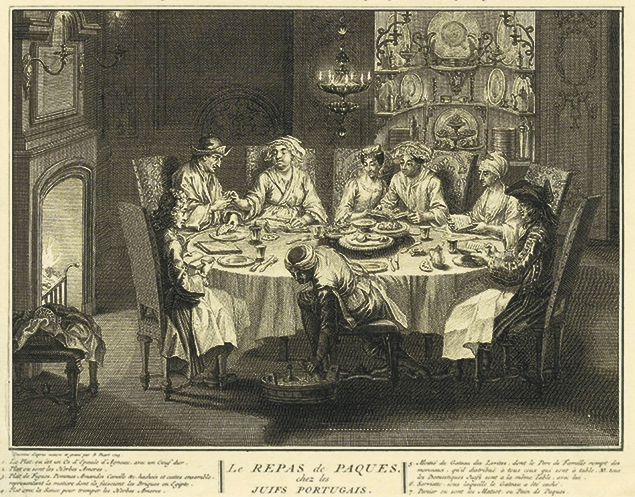
“The Passover of the Portuguese Jews,” engraved by Bernard Picart, 1732. Nathan Curiel, at the right, leads the seder. (Wikimedia Commons)
“With the Y chromosome, we can look straight back in time to the beginning of humankind.”
In the last half decade or so, scientists’ understanding of the information on the Y chromosome has grown enormously. “Four or five years ago, you could look at about 111 locations on it; now, we look at seven million of them,” Mr. Brown said. “Metaphorically, it’s as if we’ve gone from using birding binoculars to the Webb telescope. This technology” — studying both the Y chromosome and the mitochondrial DNA that comes only from your mother — “has been spurred by the human genome project, and in the last generation it has become the standard tool for scientific research and diagnostics.” It’s the technology upon which personalized cancer treatment is built — and it also traces human migration.
“Last year, scientists studied a graveyard in Erfurt, Germany, and released the results of studies of people who had been thrown down a well in Norwich, England.” All were Jews; the people in Erfurt were the victims of a pogrom in 1349. “We have compared those results to our cohort of 10,000 Jewish men and were able to directly link those people in those graves with people living today. They’re not descendants, but they share a common ancestry.”
Avotaynu has “identified over 700 different Y chromosome branches worldwide among Jews,” Mr. Brown said. “Each one of those branches dates back to a man who became — well, I can’t call it Jewish, because it is older than that, but Israelite, 3,200 years ago.”
The first evidence of “residents of Canaan identifying as Israelites is from about 3,200 years ago,” he continued. It dates to a period when the détente between the four empires that controlled the eastern Mediterranean — the Egyptians, the Hittites, the Assyrians, and the Mycenaeans — turned into a cold war, during what is called the Late Bronze Age Collapse. Its cause “is hotly debated, but what we do know is that the Egyptians who ruled Canaan withdrew, leaving the various tribes to pick up the pieces.” The first Israelites were among those tribes. “There are over 700 different Y chromosomal branches that individually date back before then,” Mr. Brown said. When you look at it this way, “there were 700 other Abrahams. And men and women have been joining the Jewish people all along. These are all cases of someone joining the Jewish community and taking his Y chromosome along.”
So how do we get to the American Revolution and South Jersey?
The historian of the large Coryell family, Lea Coryell of Lovettsville, Virginia — a retired librarian whose 33-year career at the Library of Congress saw him cataloguing the history of military science and history, “and that team also did genealogy, family history, and source books,” he said — was not satisfied with the family lore that identified Coryell as a Huguenot name. “Everything was based on tales and tradition and oral history, and it just didn’t seem right to me. I just didn’t accept it. So I turned to the Y chromosome.”
He knew that Abraham Coriell (please note, reader, that this name is spelled in many ways, both then and now) appeared in Piscataway in 1702 and seemingly vanished from history after that. He also knew that there were four Coryell men who showed up in New Jersey records; the birth and death dates made it possible, maybe even likely, that David, Emanuel, Abraham, and Samuel Coryell were Abraham Coriell’s sons. So Mr. Coryell asked 13 of the men’s descendants to test their Y chromosomes, and that led him to Avotaynu.
“I knew immediately that it was very significant,” Mr. Coryell said. “And it was a surprise.
“It was thrilling. Finally we were on the right track. All I wanted was the truth.”
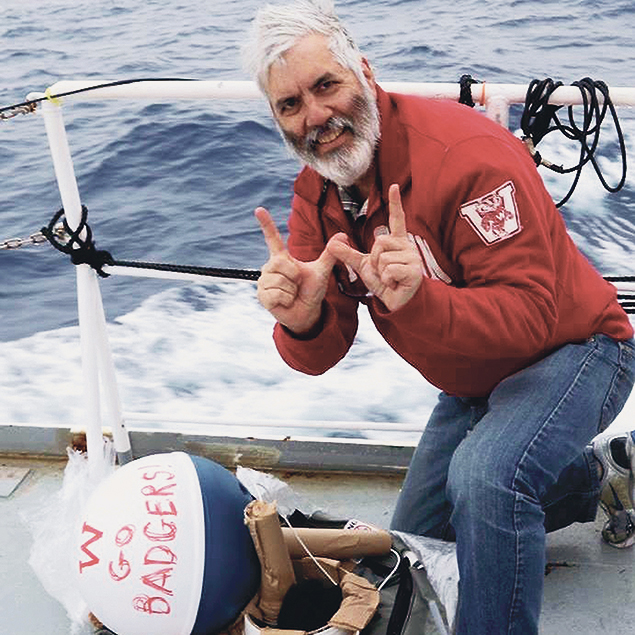
In 2016, Mr. Brown launched buoys in a remote part of the Indian Ocean as part of a study for Woods Hole Oceanographic Institute and the National Oceanic and Atmospheric Administration. (Adam Brown)
To be clear, there is nothing Jewish about the Coryell family today, and there hasn’t been for centuries. But the Y chromosome links centuries.
Who were the Coryells of New Jersey?
The details are laid out in a paper, “The Surprising Origins of the Coryell Family of Colonial New Jersey,” in the Winter 2023 issue of the journal American Ancestors. It’s written by Lea Coryell, Adam Brown, and Michael Waas.
Abraham Coriell vanished from American history after 1702, but one of his sons ran a ferry service across the Delaware River, from a town that was called Coryell’s Ferry then, and is known as Lambertville today.
“George Washington depended on that ferry through the whole war,” Mr. Brown said. “The family controlled it.” When Washington and his army were on the Pennsylvania side of the river, and Lord Cornwallis and his army were coming after them, the Coryells made sure that the ferries were on the far side of the Delaware, foiling the Redcoats. Mr. Brown said people talked about Washington pacing the Delaware’s west bank, watching the enemy as they failed to cross the river.
More than a dozen of the family’s men fought in Washington’s army — one of them was one of Washington’s pallbearers. They were friendly with Monroe, Madison, and Jefferson. One of Abraham’s grandsons, also Abraham Coriell, fought and died in the War of 1812. Another descendant, James Coryell, a Texas Ranger, was scalped by Caddo Indians while he was “raiding a bee tree,” according to American Ancestors, and was the namesake of Texas’s Coryell County.
The Coryells of today know a great deal about the last 250 or so years of their family’s history, but they did not know that their founder was Jewish. In fact, however, “he was a descendant of one of the most famous Jewish families of the 17th century,” Mr. Brown said.
“The family goes all the way back to the beginning of the Israelite identity,” he continued. “There are few others like this.”
As for the Jewish community, “it’s surprising, finding this in our backyard. We hear all about Colonial history, but not that much about Jewish Colonial history. All we hear about is Haym Salomon lending money. This family put their lives on the line.”
Avotaynu made the match between the Curiels and the Coryells through a Jewish man, a Curiel who lives in Curacao. He swabbed his cheek so scientists could study his Y chromosome.
The Curiels, according to the paper in “American Ancestors,” are descended from a man whose name we do not know yet, a Portuguese Jew who converted to Christianity during the historical period when not converting was not a viable choice for Jews. This man’s grandson, a wealthy Portuguese cloth merchant born about 1525, Duarte Nunes, had 10 children, according to a document in the Ets Haim Library in the Portuguese Synagogue in Amsterdam. One of them was a bishop. Two others went to the Ottoman Empire, where they could live as Jews, and renamed themselves Abraham and Jacob Curiel. Another brother, who remained in Portugal, had two sons who returned to Judaism. David Curiel moved to the Netherlands, and Jacob Curiel lived in Germany. Those are the earliest mentions of the name Curiel, we are told.
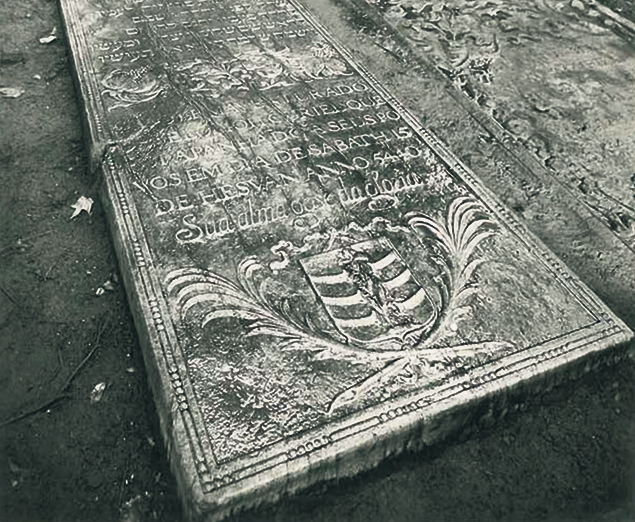
The gravestone of Selomoh Curiel, aka Manuel Nunes da Costa, who died in 1680, displays his father Jacob Curiel’s coat of arms.
Jacob Curiel, who was born in Portugal in 1587, “eventually oversaw a family trading empire that dealt in such far-flung products as Brazilian sugar and Indian diamonds,” the “American Ancestors” story tells us. As conditions in Portugal worsened, he fled to Hamburg, was a major arms supplier to Portugal during its civil war, and was lucky enough to have picked the winning side. In 1641, Portugal’s King Joao IV knighted him.
He was a spectacularly rich trader, one of the richest around, and he also was a major shareholder in the Dutch West India Company. In 1654, the company forced the mayor of New Amsterdam, the peg-legged and notoriously antisemitic Peter Stuyvesant, to allow the 24 Jews who found themselves washed up there as they fled South America, to stay.
We also know that Jacob Curiel was an ancestor of Abraham Coriell of New Jersey.
Ironically, Lea Coryell learned that his branch of the family was not actually descended from Abraham Coryell. Something happened — an adoption, a second marriage, an indiscretion, who knows? — that resulted in his branch of the family having an entirely unrelated Y chromosome. If this were 23 & Me’s finding, the odds are that someone would be very upset by it. But given the vast historic sweep of time that Y chromosomes examine, it’s just a curiosity.
Michael Waas is a historian, genealogist, partner in Hollander-Waas Jewish Heritage Services, and a co-administrator of Avotaynu DNA. He specializes in the history of Mediterranean Jews, and follows where that history leads him.
“Stories like this one surface, and it’s not unheard of for someone, as in the case of the Coryells, to leave a legacy in the form of a Christian family,” Mr. Waas said. “We have several cases of men transgressing communal boundaries. There were Portuguese Jewish men either taken to court or known to have a mistress or several mistresses who were Christian women. That was scandalous, because they lived in Christian kingdoms.
“In my own family, my ancestor had a brother who was arrested multiple times by the municipality for sleeping with Christian women from the 1650s through the 1670s, and there is a case where he is known actually to have fathered children with Christian women.
“This is an unsurprising phenomenon. The fact that it showed up so clearly is more surprising.”
There are two lessons to be drawn from this.
First, it’s that studying autosomal DNA and Y chromosomes can get you only so far. You can find lost relatives with autosomal DNA, and more distant family history from Y chromosomes, but those facts come without context. It’s only when you braid the history a researcher gleans from documents, artifacts, and other sources together with the science that you can get a rounder view of the past. Then, you can pair causes with effects. Then, you can get a story.
The other lesson in Mr. Waas’s story is that for the Y chromosomes to tell a history effectively, a father has to have lots of sons, and those sons have to have sons. These stories go down the paternal line. “The Coryells are a great example of that,” Mr. Waas said. “This was a Portuguese Jewish man and his likely Dutch consort — we have no idea if they were married — having multiple sons.”
Although this research came up with the extremely satisfying fact that an important local family that played a part in the Revolution had Jewish roots, “Remember, we’re not searching for Christians,” Mr. Brown said. “Our primary goal is understanding the migrations of the Jewish people over the last 3,200 years. But in the course of that work, we make historic discoveries.”
One reason to understand the migration, he added, is to understand the connections that Jews all around the world have to each other. We are all related. Many of us carry the same genetic material. It also is true that people who were not born Israelite, or Jewish, have joined us over the course of the millennia. All of that matters, and Avotaynu — which literally means “our fathers” but has come to mean “our ancestors” — helps discover it.
Learn more about Avotaynu at avotaynuonline.com.
